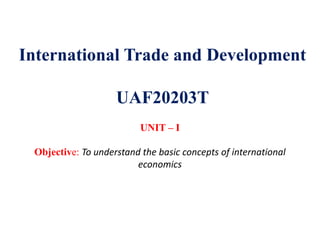
International Trade & Development - Introduction
- 1. International Trade and Development UAF20203T UNIT – I Objective: To understand the basic concepts of international economics
- 2. Meaning of Business • A business is defined as an organization or enterprising entity engaged in commercial, industrial, or professional activities. • Businesses can be for- profit entities or non-profit organizations. • Business types range from limited liability companies, sole proprietorships, corporations, and partnerships. • There are businesses that run as small operations in a single industry while others are large operations that spread across many industries around the world.
- 3. What Is Trade? • Trade is a basic economic concept involving the buying and selling of goods and services, with compensation paid by a buyer to a seller, or the exchange of goods or services between parties. Trade can take place within an economy between producers and consumers.
- 4. What is international trade? • International Trade refers to the exchange of products and services from one country to another. In other words, imports and exports. International trade consists of goods and services moving in two directions: 1. Imports – flowing into a country from abroad. 2. Exports – flowing out of a country and sold overseas.
- 5. • Visible trade refers to the buying and selling of goods – solid, tangible things – between countries. • Invisible trade, on the other hand, refers to services. • Most economists globally agree that international trade helps boost nations’ wealth. • When a person or company purchases a cheaper product or service from another country, living standards in both nations rise. • There are several reasons why we buy things from foreign suppliers. Perhaps, the imported options are cheaper. Their quality may also be better, as well as their availability.
- 6. • The exporter also benefits from sales that would not be possible if it solely sold to its own market. The exporter may also earn foreign currency. It can subsequently use that foreign currency to import things. • The term ‘commerce’ is often (not always) used when referring to the buying and selling of goods and services internationally.
- 7. Think?? • Imagine one world in which every single country traded internationally. Now imagine another world where international trade did not exist. In which world would consumers be better off? Also, in which world would the countries be richer. In the world with international trade, both the consumers and the countries would be better off.
- 8. Think?? • Products imported from Other Countries to India. • Oil. • Precious stones. • Electronics. • Heavy machinery. • Organic chemicals. • Plastics. • Animal and vegetable oil. • Iron and Steel. • Products exported from India to Other Countries • Precious Stones, Gems and Jewelry. Since ancient times, the land of India has been known for its precious stones and jewelry. ... • Petroleum Products. ... • Cereals. ... • Pharmaceutical Products. ... • Homeopathy Medicines. ... • Meat Products. ... • Traditional Handicrafts. ... • Dairy Products.
- 9. Adam Smith (1723-1790), a Scottish moral philosopher and pioneer of political economy, believed in international trade. Many economists today call Smith the ‘father of modern economics.’
- 10. Why does international trade exist? • Nations trade internationally when there are not sufficient resources or capacity to satisfy domestic needs and wants domestically. • By developing and exploiting (utilizing) their domestic resources, countries can produce a surplus. They may use this surplus to buy goods they need from abroad, i.e., through international trade.
- 11. • Our modern industrialized world would not exist if countries did not import and export. Simply - international trade is at the heart of today’s global economy. • We import goods and services for several reasons. Below are some reasons: Price: a foreign company can produce something more cheaply. Quality: may be superior. Availability: it might not be possible to produce the item locally. Therefore, the only way consumers can buy it is by importing it. A raw material, such as oil, iron, bauxite (ore of aluminium), gold, etc. might not exist at home country. Japan, for example, has no domestic reserves of oil. However, it is the fourth largest consumer of oil in the world. Japan imports virtually all its oil. Demand: might be greater than local supply. To satisfy the difference, it is necessary to import.
- 12. Advantages of international trade: • Comparative Advantage • Economies of Scale • Competition • Transfer of Technology • Jobs Disadvantages of International Trade • Over-Specialization - lose their jobs in large numbers if global demand for a product declines. • New Companies - harder to grow, to compete against giant foreign firms. • National Security - risk of being held to ransom (payoff) by the exporter(s). Strategic industries include food, energy and military equipment.
